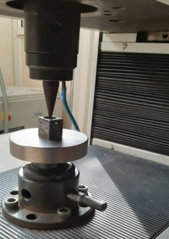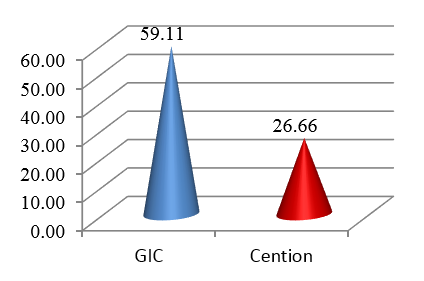Introduction
The restorative material is the one which helps to repair, replace and restore the physical, biological and mechanical function of the tooth. Due to recent advances there is availability of numerous direct filling materials to the modern dental practice - ranging from amalgams, GIC (Glass Ionomer Cement) and composites1. Amalgam is an alloy containing mercury as one of its constituents. In practice, dental amalgam is a technique-insensitive material and its long term clinical performance is exceptional. However, it have many shortcomings such as microleakage, mercury toxicity and unaesthetic appearance leads to demand of tooth colored material having better properties.1, 2 Among these only GIC have anticariogenic property due to release of fluoride in oral cavity during its chemical reaction. It also prevents demineralization and activates remineralization of tooth structure during caries activity. Other properties of GIC are its chemical adhesion to mineralized dental tissue and coefficient of thermal expansion almost similar to tooth.3 As GIC have many advantageous properties, but it cannot be used in stress bearing areas and have low mechanical properties. The longevity of restorative material depends upon many important factors. The clinical success of restoration highly depends on the bond strength of the restorative material and its adhesion to the tooth.4
A new basic filling material Cention-N has been introduced in a subgroup of composites (like oromocer or compomers) offering advantages of both amalgam and GIC. Cention-N is a tooth colored material and an “alkasite” which uses alkaline filler, capable of releasing acid neutralizing ions and substantial levels of fluoride ions.2
The aim of the study is to evaluate the effect of fluoride release on push-out bond strength of Centio-N and GIC.
Materials and Methods
A total of 16 samples of extracted non-carious mandibular molars were chosen for the study. The calculus is removed with the help of scaler followed by cleaning with pumice slurry and rubber prophylaxis cup rotating at a slow speed in the contrangle micro motor handpiece. Each tooth will be thoroughly washed and air dried. During sample preparations, standard box-type Class I cavities of 4mm × 4mm and depth of 4mm will be prepared using straight diamond burs at high speed under air-water cooling. A custom-made preparation device will allow the cavity dimensions to be standardized. Two types of materials are used for restoration. 8 samples were restored with Type ІІ GIC (GROUP 1) and the rest were restored with Cention-N (GROUP 2).
After that they were subdivided into subgroups containing 4 samples in each subgroup. They were divided on basis of storing each subgroup in deionized water separately for different days. 2 groups were stored for 1 day (GIC day 1 and Cention-N day 1) in deionized water and other 2 were stored for 7 days (GIC day 7 and Cention-N day 7). The samples were subjected to UTM (Universal Testing Machine) on Day 1 and Day 7 for measuring push- out bond strength of the samples. The data so obtained was subjected to statistical analysis.
Results
Statistics showed that the variance for push-out bond strength was not equal between the groups. Hence, Paired t-test and Unpaired t-test were applied to find the significance difference between the groups. Paired t- test showed that there is significant difference (p value- <0.001%) when the mean bond strength was compared between Day 1 and Day 7 of GIC and Cention-N. The bond strength force significantly decreases from Day 1 to Day 7 in both restorative materials. In terms of significance it is again significant with confidence of more than 99.999%. Unpaired t-test showed that there is significant difference when the mean bond strength at Day 1 and Day 7 was compared between GIC and Cention-N. The mean bond strength at Day 1 and Day 7 was significantly higher among Cention-N compared to GIC. In terms of significance it is again significant with confidence of more than 99.999% (p value- <0.001%).
The mean difference in bond strength from Day 1 and Day 7 was also compared between GIC and Cention-N using the unpaired t-test. The mean decrease in push-out bond strength from Day 1 and Day 7 was significantly more among GIC compared to Cention-N.
Discussion
Amalgam was introduced to United States in the 1830. Nowadays its used has been decreased in dentistry because of mercury toxicity and esthetics concern.5 With the advancement of other restorative materials like GIC and composite were introduced in dentistry, since then these materials have been continuously evolving. This leads to the introduction of another basic filling material Cention-N. This material is used for the study due to its mechanical properties and manipulative variables. The one of the most important mechanical property is bond strength of the material, as the material should provide sufficient strength to overcome the intraoral functional and parafunctional forces. The bond strength tests that can be performed are shear, tensile, microshear, and microtensile but they are performed on flat surfaces which have low C-factor and stress generation is not directed to bonded surfaces 1, 6, 7 Rather than these tests Push-out bond strength test was selected in this study as it has ability to test the bond strength in high C-factor cavity (5.0) with high stress generation towards the bonded surfaces. 8
The present study was conducted to compare and evaluate the push out bond strength of Cention N with GIC when placed in deionized water. However this aspect have not been studied yet. Usually, the push-out bond strength test evaluates the bond strength of endodontic cements to the radicular channels. However, in the present study, the push-out test was adapted to evaluate the bond strength of GIC and Cention-N in a simulated Class I cavity when they are stored in deionized water. 9
Deionized water was preferred as the storage medium over artificial saliva, as saliva has high viscosity and the presence of ions. These ions may affect the release of fluoride ions from the materials, thus leading to an inaccurate estimation. The storage medium was changed in every 24 h due to the possibility of saturation of released fluoride ions in the storage medium, which interferes with further release of fluoride ions. 3
The results of this study shows that when GIC and Cention-N is stored in deionized water their pushout bond strength decreases but the decrease in pushout bond strength is more in GIC as compared to Cention-N. And when GIC and Cention-N are compared in terms of bond strength it is significantly more in Cention-N than GIC.
According to this study overall Cention-N has better bond strength than GIC as Cention-N has a combination of UDMA, DCP, an aromatic aliphatic-UDMA and PEG-400 DMA, interconnects (cross-links) during polymerization resulting in strong mechanical properties and good longterm stability. Due to the sole use of cross-linking methacrylate monomers in combination with a stable, efficient self-cure initiator, Cention N exhibits a high polymer network density and degree of polymerization over the complete depth of the restoration. 10, 11, 12
According to another study in neutral pH, GIC released significantly higher amounts of fluoride ion when compared to Cention-N (self-cure and light-cure) at Day 7. This may be because of relatively higher filler content in GIC (99.9%). In addition, fillers in Cention-N are surface modified, thus becoming resistant to degradation and may lead to the release of a lesser amount of fluoride ions. 3 This can also explain the higher bond strength in Cention-N at Day 7 than GIC when placed in deionised water.
As this is an in-vitro study and is not performed earlier therefore, more in-vivo studies are required to come to a definitive conclusion.




